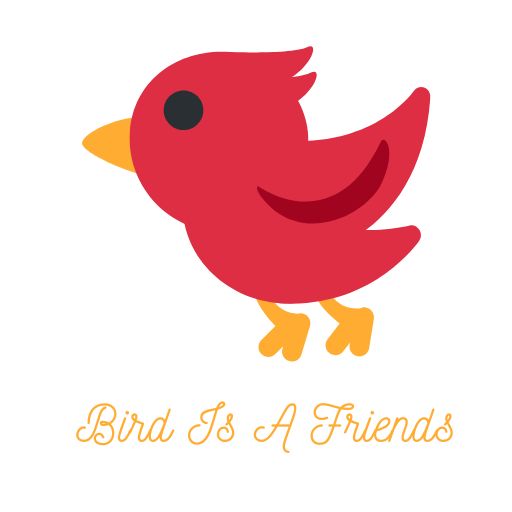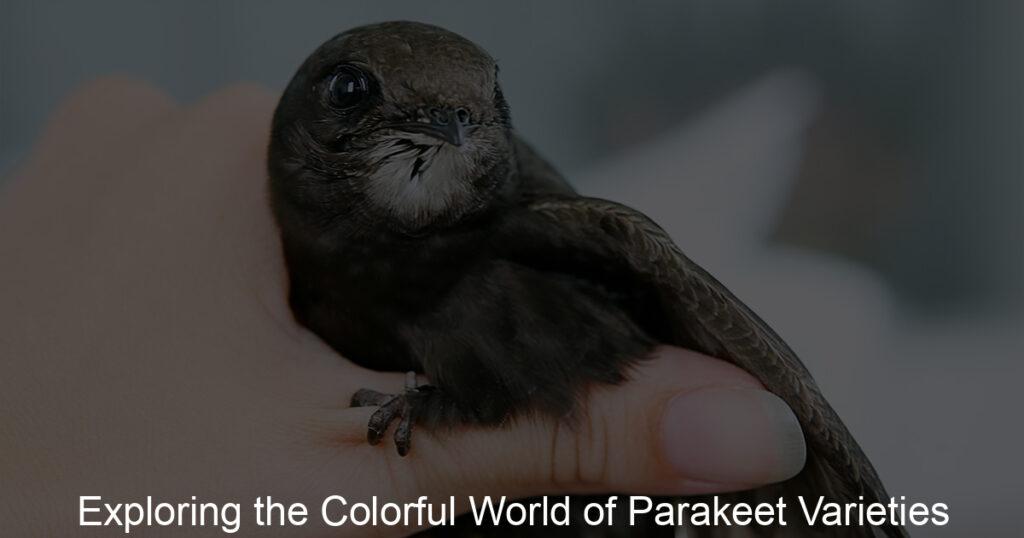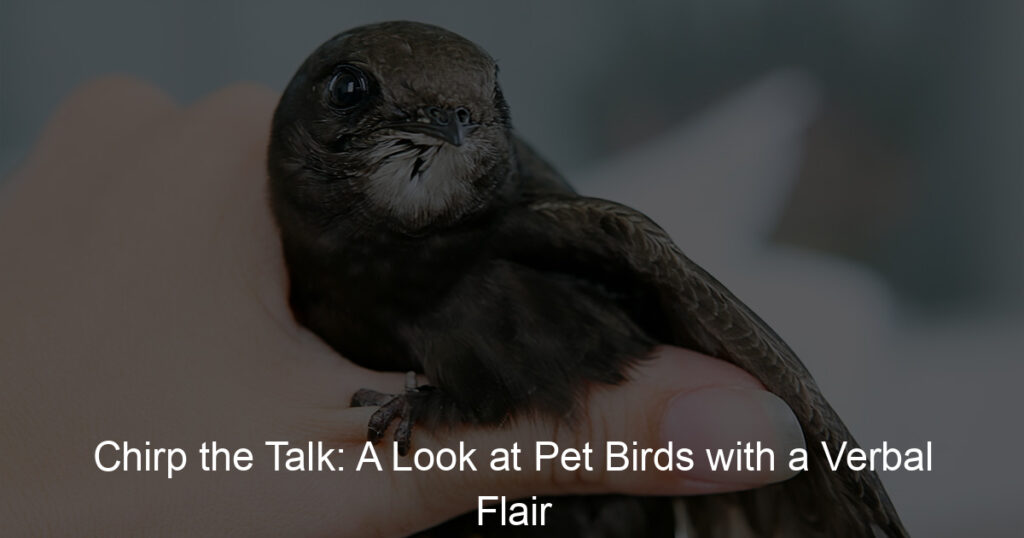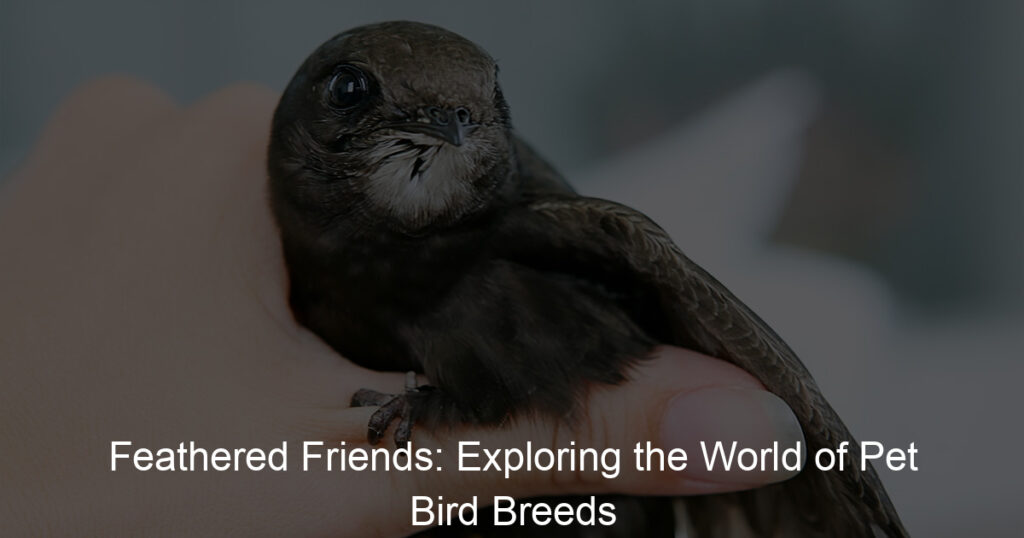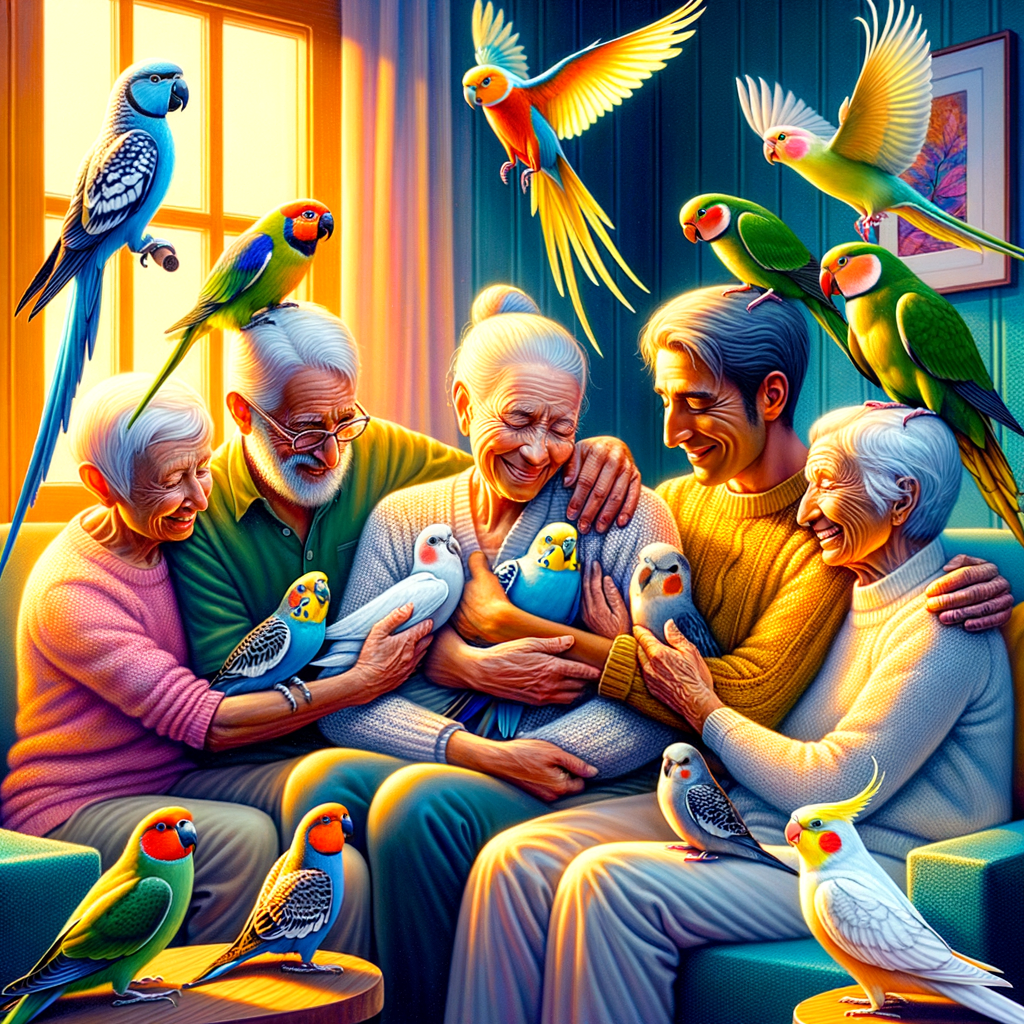
Introduction: Birds as Pets
When it comes to pets, birds often fly under the radar. However, these feathered friends have a lot to offer and are becoming increasingly popular as pets. In this article, we will explore the unique aspects of pet bird behavior and understand why they are such a hit with pet lovers.
- Exploring the popularity of birds as pets
According to the American Pet Products Association, there are over 20 million pet birds in the United States alone. This number has been on the rise over the past few years, showing that more and more people are discovering the joy of having a bird as a pet.
One of the reasons for their popularity is their lifespan. Unlike other pets, many bird species can live for decades, providing companionship for a significant part of their owners’ lives. Additionally, birds are known for their vibrant colors and unique personalities, which make them an exciting addition to any household.
- Understanding the unique aspects of pet bird behavior
Every bird species has its unique behavior, which can be fascinating to observe and understand. For instance, parrots are known for their intelligence and ability to mimic human speech, while canaries are loved for their beautiful singing.
It’s important to note that birds are highly social creatures. They thrive on interaction and can form strong bonds with their human caretakers. However, they also require a lot of care and attention. They need a balanced diet, regular exercise, and mental stimulation to stay happy and healthy.
Understanding your bird’s behavior can help you provide the best care for them and strengthen your bond. For example, if your bird is fluffing its feathers, it could be a sign that they are relaxed and comfortable. On the other hand, a bird that is constantly picking at its feathers could be stressed or ill.
In conclusion, birds make wonderful pets for those who are willing to invest the time and effort into understanding and caring for them. Their unique behaviors and personalities make them a joy to have around, and their increasing popularity is a testament to the many benefits they bring to their owners.
The Affectionate Side of Feathered Pets
When we think of pets, we often imagine dogs wagging their tails or cats purring in our laps. But birds, too, have a unique way of showing affection. Let’s delve into the fascinating world of bird affection.
Understanding Bird Affection
Unlike dogs and cats, birds express their affection in different ways. It’s essential to understand these signs to build a strong bond with your feathered friend.
- How birds show affection
- Common misconceptions about bird affection
Birds show affection through various behaviors. Some birds may preen or groom you, which is a sign of trust and bonding. Others might nuzzle against you or chirp happily when you’re around. Some birds might even share their food with you, which is a significant sign of affection in the bird world.
Many people believe that birds are not affectionate creatures. This misconception stems from the fact that birds express their affection differently than mammals. For instance, a bird might not cuddle with you, but it might show its affection by preening you or sharing its food with you. Understanding these signs can help you appreciate the affectionate side of your feathered pet.
Understanding bird affection is the first step towards building a strong bond with your feathered friend. Remember, every bird is unique, and they might show their affection in different ways. So, keep an eye out for these signs and enjoy the affectionate side of your feathered pet.
Emotional Bond with Birds
Building an emotional bond with your feathered friend is not only rewarding, but it also enhances your bird’s quality of life. Let’s explore how you can foster this bond and delve into a heartwarming case study that exemplifies the deep connection between a bird and its owner.
- How to Build an Emotional Bond with Your Bird
Creating an emotional bond with your bird requires patience, consistency, and understanding. Here are some tips to help you build this bond:
- Time: Spend quality time with your bird. This could be playing, talking, or simply sitting together.
- Trust: Birds are naturally cautious creatures. Building trust takes time and patience. Avoid sudden movements and loud noises that may scare your bird.
- Communication: Learn your bird’s unique language. Pay attention to their sounds, body language, and behaviors to understand their needs and emotions.
- Training: Use positive reinforcement techniques to train your bird. This not only teaches them new skills but also strengthens your bond.
- Case Study: A Heartwarming Story of a Parrot and Its Owner
Let’s look at the touching story of Polly, a vibrant African Grey parrot, and her owner, Mary. Mary adopted Polly when she was just a few weeks old. Over the years, they developed an incredible bond that transcended the usual pet-owner relationship.
Mary spent countless hours interacting with Polly, learning her unique sounds, and responding to her needs. She used positive reinforcement to teach Polly various tricks and commands. But their bond was not just about training. Mary and Polly shared quiet moments together, simply enjoying each other’s company.
One day, Mary fell ill and was bedridden. Remarkably, Polly seemed to sense this change. She stayed by Mary’s side, offering comfort with her presence and soft chirps. This story beautifully illustrates the deep emotional bond that can form between a bird and its owner.
In conclusion, building an emotional bond with your bird is a rewarding journey. It requires time, patience, and understanding, but the result is a unique and fulfilling relationship that enriches both your lives.
Do Birds Enjoy Cuddles?
Many bird owners often wonder if their feathered friends enjoy cuddles. The answer is, it depends on the bird. Some bird species are more affectionate than others and may enjoy a gentle stroke or a cuddle. However, it’s essential to understand how to interact with your bird safely and recognize signs of discomfort.
Cuddle Buddies: Birds and Human Interaction
Interacting with your bird can be a rewarding experience. However, it’s crucial to do it in a way that respects the bird’s boundaries and ensures their comfort. Here are some tips on how to safely cuddle with your bird and understand the signs of discomfort.
- How to safely cuddle with your bird
- Understanding the signs of discomfort in birds
When cuddling your bird, always be gentle and slow. Avoid sudden movements that might scare them. Start by slowly moving your hand towards them. If they seem comfortable, you can gently stroke their feathers. Remember, some birds may not like to be touched at all, and that’s okay. Always respect their boundaries.
It’s important to understand your bird’s body language to know when they are uncomfortable. Signs of discomfort can include trying to move away from you, fluffing up their feathers, or making certain sounds. If you notice any of these signs, it’s best to give your bird some space.
In conclusion, while some birds may enjoy cuddles, it’s essential to approach them with care and respect their boundaries. Always be attentive to their body language and signs of discomfort. Remember, a happy bird is a healthy bird!
Affectionate Bird Species
When it comes to feathered friends, some species are more affectionate than others. Let’s explore the top five bird species known for their warm nature, and delve into a case study of the lovebird, often referred to as nature’s cuddle buddy.
- Top 5 Bird Species Known for Their Affectionate Nature
- Case Study: The Lovebird – Nature’s Cuddle Buddy
Here are the top five bird species that are known for their affectionate nature:
| Rank | Bird Species |
|---|---|
| 1 | Cockatoos |
| 2 | Parakeets |
| 3 | Canaries |
| 4 | Lovebirds |
| 5 | Finches |
These birds are not just beautiful to look at, but they also form strong bonds with their human companions. They enjoy being petted and spending time with their owners, making them perfect for those seeking a pet with a loving nature.
Lovebirds are small parrots that are famous for their affectionate nature. They are known as ‘Nature’s Cuddle Buddy’ because of their love for snuggling with their partners. These birds are monogamous and form strong bonds with their mates.
Lovebirds are also known for their playful nature. They enjoy interacting with their human companions and are known to show affection by preening or feeding their human friends. They are social birds and thrive when they have company.
However, it’s important to remember that every bird is unique. While lovebirds are generally affectionate, individual birds may have different personalities and comfort levels with human interaction. It’s essential to respect their boundaries and provide them with a safe and comfortable environment.
Understanding Bird Behavior
One of the most fascinating aspects of keeping birds as pets is their unique behavior. Birds are highly intelligent creatures with a wide range of emotions and behaviors. In this section, we will delve into the affectionate side of our feathered friends.
Birds Showing Affection
Just like humans, birds show affection in their own special ways. Understanding these signs can help you build a stronger bond with your pet bird.
- Common signs of affection in birds
- How to respond to your bird’s affectionate behavior
Birds show affection in various ways. Some birds may gently peck or nibble at their owners, which is a sign of trust and affection. Others may fluff up their feathers or bob their heads, indicating they are comfortable and content. Some birds may even cuddle or snuggle up to their owners, showing a deep level of trust and affection.
Responding to your bird’s affectionate behavior is crucial in building a strong bond. If your bird is showing signs of affection, it’s important to respond positively. This can be as simple as speaking softly to your bird, gently stroking its feathers, or even offering a favorite treat. Remember, it’s important to respect your bird’s boundaries and never force interaction.
Understanding your bird’s behavior is key to building a strong and loving relationship. By recognizing and responding to your bird’s signs of affection, you can ensure a happy and healthy environment for your feathered friend.
Interpreting Bird Behavior
Understanding your bird’s behavior is crucial for a healthy and happy relationship with your feathered friend. Let’s delve into some key takeaways and a case study to illustrate the importance of interpreting bird behavior.
- Key takeaways for understanding your bird’s behavior
- Case study: How understanding bird behavior can improve your relationship with your pet
Observing and understanding your bird’s behavior can provide valuable insights into their health and happiness. Here are some key points to remember:
| Behavior | Interpretation |
|---|---|
| Chirping and Singing | Indicates happiness and contentment |
| Preening | Sign of comfort and trust |
| Fluffing Feathers | Could mean the bird is cold, relaxed, or unwell |
| Beak Grinding | Sign of contentment and relaxation |
Remember, every bird is unique. What might be normal behavior for one might not be for another. Always pay attention to any sudden changes in behavior as it could indicate stress or illness.
Consider the story of Charlie, a pet parakeet. Charlie’s owner noticed that Charlie had started to fluff his feathers more often and was less active. Instead of dismissing this as a mood swing, the owner recognized it as a potential sign of illness from his understanding of bird behavior. A quick visit to the vet confirmed that Charlie was indeed unwell. Early detection and treatment ensured Charlie’s swift recovery. This case study highlights the importance of understanding bird behavior in maintaining the health and happiness of our feathered friends.
In conclusion, understanding and interpreting bird behavior is not just about improving your relationship with your pet. It’s about ensuring their health and happiness. As bird owners, it’s our responsibility to learn their language and respond accordingly.
Conclusion: The Joy of Having Affectionate Feathered Friends
As we conclude our journey into the world of feathered pets, let’s take a moment to reflect on the joy and emotional bond that comes with having these affectionate creatures in our lives.
- Recap of the emotional bond with birds
Throughout this article, we’ve explored how birds, often underestimated as pets, can form deep emotional bonds with their human companions. We’ve seen how birds can recognize their owners, respond to their voices, and even show signs of affection. We’ve learned that birds, just like dogs or cats, can become a significant part of our lives, providing companionship, joy, and a unique bond that can last for years.
- Final thoughts on the affectionate side of feathered pets
Feathered pets are not just beautiful to look at; they are intelligent, affectionate, and capable of forming deep emotional connections with their owners. Owning a bird is a commitment, but it’s one that comes with numerous rewards. The affectionate side of these pets can bring a lot of joy and happiness into our lives.
Remember, every bird is unique, with its own personality, likes, and dislikes. Understanding their behavior and providing them with the care they need is the key to a happy and healthy relationship with your feathered friend.
So, whether you’re considering getting a bird or already have one, we hope this article has shed some light on the wonderful world of feathered pets and the joy they can bring into our lives.
